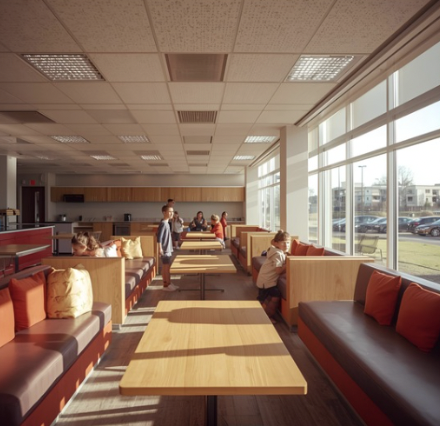
Earlier this semester, The Columbus School decided to remove the cafeteria sofas after they were damaged and misused by students. The choice upset many students who used the sofas every day to relax and hang out with friends. Without them, the cafeteria feels different and less comfortable than before.
For years, the sofas had been a favorite spot where students could rest, talk, or eat during breaks and free periods. Their sudden removal surprised many and made students wonder about respect for school property and shared spaces. The school wanted to remind students to take better care of what’s provided, but some felt it was unfair to punish everyone for the actions of a few.
“I used them almost every day. At lunch, during breaks, or free periods, the sofas were always where my friends and I went first,” said senior Mariana Cortés. “They were comfortable, so it was a nice place to just sit, rest, and hang out.”
The sofas were located near the main cafeteria area, so students from grades 6th to 12th grade used them. For many, it was a place to relax in between classes or spend time with friends. When students came back and saw the sofas were gone, the change was obvious right away.
Cortés said she didn’t think the decision was fair to everyone. “I don’t think it was totally fair,” she said. “Some students didn’t treat the sofas well, but most of us did. The school could have tried other solutions before taking away something that was so important for us.”
Other students felt the same way. Michelle Niehaus, a ninth grader, said she wasn’t surprised but was still disappointed. “Honestly, I wasn’t shocked because people had been messing them up,” she said. “But I was still disappointed, because it felt like the cafeteria lost its main hangout spot.”
Before they were removed, the sofas were one of the few places on campus where students could really relax. “To me, the sofas showed that the school trusted us and cared about giving us a nice place to hang out,” said Cortés. “They also represented comfort; having a place to rest made the cafeteria feel welcoming and more like home.”
Niehaus agreed, saying the sofas gave students a sense of freedom. “It was one of the few places in school where you could actually relax and not feel like you were in a classroom,” she explained. “It sucks, because not everyone did that. A lot of us actually used them respectfully, but we’re all being punished for the actions of a few people.”
Both students hope the school will consider bringing something similar back in the future. “Maybe stronger couches, bean bags, or comfy chairs that are harder to damage,” said Cortés. Niehaus added, “Yeah, maybe something easier to clean and take care of, like chairs with cushions or outdoor benches. Something that still feels comfortable but not as easy to ruin.”
The situation shows a bigger issue that many schools face: how to give students comfortable spaces while also keeping them in good condition. The Columbus School wants students to take better care of shared areas and be responsible for their environment. Shared spaces like the sofas matter because it is one of the few places where students had to relax and were comfortable. While the sofas’ removal may remind students about the importance of respect, it also started a conversation about how they can earn that trust again.
Even though the sofas are gone, students are still talking about them. Many hope the school can find a new solution that brings back the same comfort and community they once had. As Cortés said, “We just want the cafeteria to feel welcoming again.”


